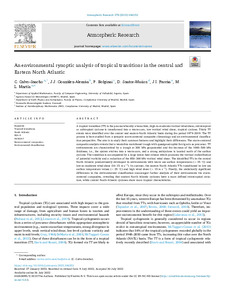Por favor, use este identificador para citar o enlazar este ítem:
http://hdl.handle.net/20.500.11765/13955
An environmental synoptic analysis of tropical transitions in the central and Eastern North Atlantic
Registro completo de metadatos
| Campo DC | Valor | Lengua/Idioma |
|---|---|---|
| dc.contributor.author | Calvo Sancho, Carlos | es_ES |
| dc.contributor.author | González-Alemán, Juan Jesús | es_ES |
| dc.contributor.author | Bolgiani, Pedro | es_ES |
| dc.contributor.author | Santos Muñoz, Daniel | es_ES |
| dc.contributor.author | Farrán Martín, José Ignacio | es_ES |
| dc.contributor.author | Martín Pérez, María Luisa | es_ES |
| dc.date.accessioned | 2022-09-12T10:55:10Z | - |
| dc.date.available | 2022-09-12T10:55:10Z | - |
| dc.date.issued | 2022 | - |
| dc.identifier.citation | Atmospheric Research. 2022, 278, p. 106353 | es_ES |
| dc.identifier.issn | 0169-8095 | - |
| dc.identifier.uri | http://hdl.handle.net/20.500.11765/13955 | - |
| dc.description.abstract | A tropical transition (TT) is the process whereby a baroclinic, high-to-moderate vertical wind shear, extratropical or subtropical cyclone is transformed into a warm-core, low vertical wind shear, tropical cyclone. Thirty TT events were identified over the central and eastern North Atlantic basin during the period 1979–2019. The TT process is here studied from a synoptic storm-centered composite climatology and an environmental classification perspective. The aim is to study their common features and highlight their differences. The storm-centered composite analysis reveals that a westerlies meridional trough with quasigeostrophic forcig acts as precursor. TT environments are characterized by a trough at 300 hPa geopotential and the increase of the 1000–500 hPa thickness, i.e., the system evolves into a warm-core, and a strong anticyclone is located north of the surface cyclone. The transition is accompanied by a large latent heat release which promotes the vertical redistribution of potential vorticity and a reduction of the 850–300 hPa vertical wind shear. The identified TTs in the central North Atlantic predominantly developed in environments with warm sea surface temperatures (> 25 ◦C) and low-to-moderate wind shear (10–15 m s − 1 ). In contrast, the eastern North Atlantic TTs transitioned in low sea surface temperature values (< 25 ◦C) and high wind shear (> 15 m s − 1 ). Finally, the statistically significant differences in the environmental classification encouraged further analysis of their environments via stormcentered composites, revealing that eastern North Atlantic cyclones have a more defined extratropical structure, while central North Atlantic cyclones show more tropical characteristics. | es_ES |
| dc.description.sponsorship | This work was partially supported by research projects PID2019-105306RB-I00 (IBERCANES) and CGL2016-78702 (SAFEFLIGHT). This work is also supported by the ECMWF Special Projects SPESMART and SPESVALE. C. Calvo-Sancho acknowledges the grant awarded by the Spanish Ministry of Science and Innovation - FPI program (PRE2020-092343). | es_ES |
| dc.language.iso | eng | es_ES |
| dc.publisher | Elsevier | es_ES |
| dc.rights | Licencia CC: Reconocimiento–NoComercial–SinObraDerivada CC BY-NC-ND | es_ES |
| dc.subject | Tropical transitions | es_ES |
| dc.subject | North Atlantic | es_ES |
| dc.subject | ERA-5 | es_ES |
| dc.subject | HURDAT | es_ES |
| dc.subject | Storm-centered composites | es_ES |
| dc.subject | Environmental classification | es_ES |
| dc.title | An environmental synoptic analysis of tropical transitions in the central and Eastern North Atlantic | es_ES |
| dc.type | info:eu-repo/semantics/article | es_ES |
| dc.relation.publisherversion | https://doi.org/10.1016/j.atmosres.2022.106353 | es_ES |
| dc.rights.accessRights | info:eu-repo/semantics/openAccess | es_ES |
| Colecciones: | Artículos científicos 2019-2022 | |
Ficheros en este ítem:
| Fichero | Descripción | Tamaño | Formato | ||
|---|---|---|---|---|---|
| AR_2022_Calvo.pdf | 23,37 MB | Adobe PDF |  Visualizar/Abrir |
Los ítems de Arcimis están protegidos por una Licencia Creative Commons, salvo que se indique lo contrario.





